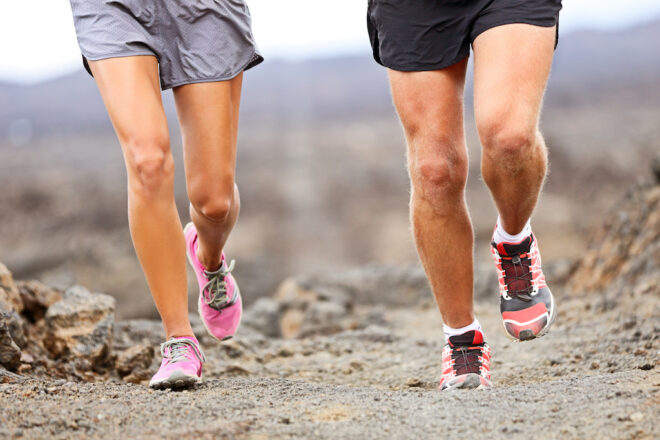Living your life to the fullest can be a dangerous proposition, when it gets to running – common foot injuries is that exact danger.
Sure the couch is safe, but there’s so much life to live out there in the big, dangerous world. Running, like any physical activity, carries with it some minor risk, but all health benefits easily outweigh the risk of injury. That said, it doesn’t hurt to brush up on some runner’s first aid.
Here’s a list of common foot injuries, how they happen, how to treat them, and, most importantly, how to avoid them.
In This Article:
What are the Most Common Foot Injuries among Runners?
Most common running injuries include:
- Runners’ knee
- Plantar fasciitis
- Iliotibial band (ITB) syndrome
- Achilles tendonitis
- Shin splints
- Stress fractures
Being on your feet a lot will inevitably lead to some problems, and galloping 10 miles every day on concrete will definitely cause some issues.
Over long periods of time, runners can develop awful-sounding stuff like hallux rigidus (stiff big toe), metatarsalgia, Morton’s neuroma, extensor tendonitis, and adductor and abductor hallucis.
The truth is, while those do sound scary, you’re more likely to face many of the more common problems listed below. And if you can manage to avoid the more common problems, you’ll also likely dodge the big, scientific stuff.
Runner’s Knee
Do your knees feel unusually sore after a run or intensive workout? Runner’s knee stems from load-bearing movements coming down on the knee joint in a flexed position.
Whenever you hit your stride, you impact your bent knee as your front foot makes contact with the running surface. This blunt force can lead to severe pain, especially if you’re not running in the correct form or overdoing deep squats and stair climbs.
Remedy runner’s knee with more stretching and strength exercises. Stretching out your calves and hamstrings can lower the risk of injury. Strengthen those same muscles by doing more activities such as clam shells, donkey kicks, straight leg raises.
Plantar Fasciitis
Are you experiencing some crippling heel pain? It could be plantar fasciitis (PF). PF is the inflammation or swelling of a thick band of tissue that connects your heel bone to your toes and runs across the bottom of your foot.
PF is the result of age, obesity, and abnormal foot mechanics, and it has been linked to many professionals who spend most of their day on their feet.
You’re going to need to consult a doctor if you believe you may have PF. From there, you will likely need some physical therapy and custom orthotics.
Ultimately, you may even need medication, a night brace or splint, or even surgery in severe cases. It’s essential to get it checked as soon as possible. PF only gets more challenging to cure the longer you postpone treatment.
PF is by no means a death sentence for your running career if you see a doctor. Don’t be stubborn and get yourself checked out.
Iliotibial band (ITB) syndrome
Iliotibial band tendon, which is on the outside of your leg running from top of pelvic bone to the knee, gets irritated or swollen from rubbing against your hip or knee bones. Iliotibial band syndrome is common among runners and young people doing frequent exercises.
Iliotibial band syndrome can cause hip pain, knee pain, warmth & redness on outside the knee, and you may also feel a snap, pop or click on the outside of your knee.
Rest and pain medications (NSAIDs) can give relief. However, you may require professional support depending on severity. If you are a runner, you can try to change certain things – such as, avoid running up a hill or down a slop, adjust your posture if needed, do proper warm-ups and cool-downs before and after running respectively, and use right shoes – to prevent Iliotibial band syndrome.
Shin Splints
Common in athletes, dancers, and soldiers – shin splints refer to pain in the shin caused by inflammation or swelling of the muscles surrounding your shin bones.
Shin splints can manifest as a shooting stab or a dull ache. These are caused by overworking yourself and suddenly changing training or workout routines.
Resolve shin splints with plenty of ice and rest. Get ahead of shin splints by making sure you have proper footwear with appropriate arch support and try to find a way to lessen the impact on your legs during exercise.
Achilles Tendonitis
Achilles tendonitis (AT) is another injury caused by overworking a muscle and not allowing enough rest. The Achilles tendon is the muscle located at the back of the foot above the heel stretching up the rear of your leg.
Overworking this muscle can weaken it and raise the risk of a tear or rupture. A torn Achilles is not a fun injury.
Again, keep AT at bay by gradually switching the intensity of workouts and resting between prolonged exertion periods.
Stress Fractures
Stress fractures are little, tiny cracks caused by repeated stress and impact often found in the bottom of your feet. These sound a bit worse than they are. Bones do this all the time to repair and strengthen themselves.
While stress fractures can be painful, you can avoid them by making sure you make time for recovery. It would be best to give your bones time to heal and strengthen before putting more force on them.
Avoid stress fractures by changing your exercise routines and regimens gradually over time. Also, try avoiding heavy load-bearing exercise and be sure to rest between intensive periods of activity. Proper, supportive footwear, more calcium in your diet can also help mitigate the risks.
Blisters and Chafing
Though overlooked by most people, blisters, and chafing have likely ended more exercises than all the other injuries combined. These are any skin irritations – sores, cuts, or rashes – caused by persistent rubbing and pressure.
Properly fitting clothes and shoes made of loose non-abrasive material should do the trick. Also, with blisters, make sure to keep your feet dry and change socks often. Applying various powders, creams, and even vaseline to any trouble spot you’re struggling with will help as well.
Lastly, clean, dress, and bandage any open wounds and avoid any activity that encourages contact to the affected area.
Strains, Sprains, and Tears
If you’re a runner, you most likely know what a pulled muscle is and how it feels. That is a strain, an extended or torn part of a muscle or tendon, and it varies significantly in severity. Please treat it with loads of ice and rest.
A sprain is a tear of a ligament that attaches a muscle to a joint. It also varies in severity but is often worse than a strain. You will need to keep pressure off the joint, elevate and ice it, and take some time off from activity.
Based on the severity, or the amount of pain you are in, you may have to seek a doctor for treatment with both of these injuries.
How to Prevent Foot Injuries
Being smart and knowing your body is crucial to preventing foot injuries. On top of that, here are some simple tips for avoiding foot injuries while running:
- Always warm up (and cool down) and take the time to stretch before and after any physical activity! Going from a dead stop straight into strenuous exercise is a recipe for disaster.
- When in doubt, ice it and rest it! Most running injuries can sort themselves out with a little TLC. Ice will reduce swelling, and rest will allow the body to heal.
- Many injuries are caused by changing up your exercise intensity too quickly. Take your time and increase your output gradually, or you may be out of action in a hurry.
- Wear the right shoes and the right socks, and please make sure they’re dry! Avoid chafing and fungus by simply making sure everything fits, is in good shape, and is dry.
- Focus on your running form. Poor form won’t hurt you at first, but multiply that over hundreds or thousands of runs, and you have a recipe for disaster.
One last thing: always listen to your body. If you are in a lot of pain, or you’ve lost mobility, or something isn’t right – go to the doctor!
Key Takeaways
Injuries happen. At times there’s not much we can do to dodge them, but many running injuries can be avoided by taking a few necessary steps.
Here you’ll find a breakdown of the most common running injuries. Find out what they are, how to avoid them, and how to best treat them. Run with confidence and know that you’re doing everything you can to be safe out on the street, track, and trail.
- Runner’s knee, stress fractures, plantar fasciitis, shin splints, and Achilles tendonitis can all end your daily running routine if left ignored or untreated.
- Blisters and chafing are minor but extremely uncomfortable and preventable.
- Strains, sprains, and tears range from minor to very serious injuries, which require ice, rest, and a possible professional consultation.
- Always take time to warm up, cool down, and stretch before and after any physical activity.














